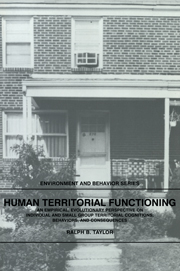 Human Territorial Functioning
Human Territorial Functioning Book contents
- Frontmatter
- Contents
- List of figures, tables, and boxes
- Series foreword
- Preface
- Acknowledgments
- 1 Introduction
- PART I ORIGINS OF HUMAN TERRITORIAL FUNCTIONING
- PART II A CONCEPTUAL MODEL OF HUMAN TERRITORIAL FUNCTIONING
- PART III TERRITORIAL FUNCTIONING IN SETTINGS OF VARYING CENTRALITY
- 7 Interior residential settings
- 8 Territorial functioning in outdoor residential spaces close to the home
- 9 Regular use settings
- 10 Minimal territorial functioning
- PART IV APPLICATIONS TO SOCIAL PROBLEMS
- PART V REVIEW AND PROSPECTS
- Index
8 - Territorial functioning in outdoor residential spaces close to the home
Published online by Cambridge University Press: 05 February 2010
- Frontmatter
- Contents
- List of figures, tables, and boxes
- Series foreword
- Preface
- Acknowledgments
- 1 Introduction
- PART I ORIGINS OF HUMAN TERRITORIAL FUNCTIONING
- PART II A CONCEPTUAL MODEL OF HUMAN TERRITORIAL FUNCTIONING
- PART III TERRITORIAL FUNCTIONING IN SETTINGS OF VARYING CENTRALITY
- 7 Interior residential settings
- 8 Territorial functioning in outdoor residential spaces close to the home
- 9 Regular use settings
- 10 Minimal territorial functioning
- PART IV APPLICATIONS TO SOCIAL PROBLEMS
- PART V REVIEW AND PROSPECTS
- Index
Summary
If one is to tell what is going on in a residential area, it can be much more useful to look at the decoration of the windows, the cleanliness of the sidewalks, and the neatness of the lawns, than at the style and scale of the houses.
– Don Appleyard, “Environment as a Social Symbol”“A lot of people say it's tacky… I don't know… One flamingo… maybe that's tacky. I've got thirty-four.”
– Don Featherstone, of Union Products, Inc., inventor of the pink flamingo lawn ornament. Interview on National Public Radio's “All Things Considered,” July 31, 1987In this chapter we move out of interior residential settings and into the spaces surrounding them: outdoor residential spaces close to the home. The locations to be considered include front steps, porches and front yards, driveways, backyards, alleys, sidewalks, and the street itself. These exterior locations not only encapsulate the interior residential spaces where person-place transactions are of highest centrality. They are also linked with interior settings in a number of important ways. Quality of life in the interior residential setting is shaped by events, people, and conditions in the adjoining outdoor spaces.
Transactions in outdoor residential spaces rank second highest on the centrality dimension for a simple reason: They are always there. In leaving the residence and returning home, occupants must traverse these spaces.
- Type
- Chapter
- Information
- Human Territorial FunctioningAn Empirical, Evolutionary Perspective on Individual and Small Group Territorial Cognitions, Behaviors, and Consequences, pp. 166 - 197Publisher: Cambridge University PressPrint publication year: 1988
